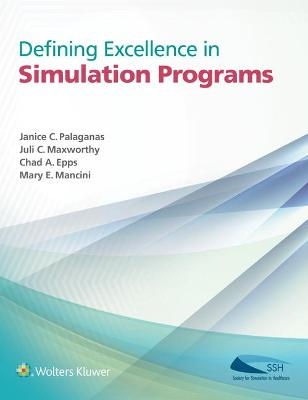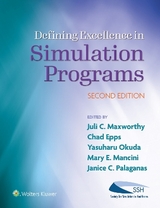
Defining Excellence in Simulation Programs
Lippincott Williams and Wilkins (Verlag)
978-1-4511-8879-0 (ISBN)
- Titel erscheint in neuer Auflage
- Artikel merken
Defining Excellence in Simulation Programs is an official publication of the Society for Simulation in Healthcare (SSH), created to support the Society’s mission to encourage excellence in healthcare education, practice and research through the use of simulation.
With nearly 140 expert clinicians and educators contributing, this authoritative guide offers clear-cut definitions, recommendations and best practices for all types of simulation training programs. This is a must-read for healthcare managers, educators and researchers looking to create or manage successful, cost-effective, researched-based simulation programs.
A wide range of topics -- essential to the development and management of successful and cost-effective simulation programs – include: Simulation Standards – best practices and program development; Types of Simulation Programs – infrastructure, framework; Simulators – types, selection and usage; Funding – fundraising, income sources; Management – asset management, policies and procedures; Environmental Design – building a simulation center; technical infrastructure; and Educational Development; Faculty Development; Research, and more, including:
• Well-referenced, reader-friendly content is continually available, practical and timely
• Standards and recommendations based on actual programs around the world that have proven to be sustainable, cost-effective and successful
• Editors and many authors central to SSH’s role in learning and defining best practices for simulation and simulation program management
• Interprofessional group of editors and authors offering diverse perspectives, from areas of nursing, medicine, allied health, numerous specialties, and non-clinical fields
including organizational behavior, psychology, statistics, business, and engineering
• Terms of Reference – Defines and standardizes simulation terms and concepts for users, learners and developers
• Experts Corner – Commentary on particular areas of training, research and program development by simulation experts and founders
• Consider This – Text boxes provide practical how-to sections on important related topics >
Janice Palaganas, PhD, RN, NP is a Lecturer for Harvard Medical School and the Associate Director of the Institute for Medical Simulation in Boston, Massachusetts – the most renown program for interprofessional simulation educator training. A recognized leader and expert in the field of simulation, Dr. Palaganas is Principal Faculty for the Center for Medical Simulation, the implementing director of the Society for Simulation in Healthcare’s (SSH) Accreditation and Certification Program, and Chair of the 2011 Simulation and IPE Symposium. Dr. Palaganas is also an author for the National League for Nursing (NLN) study for high-stakes assessment using simulation for nursing students and authored and evaluated the challenges of assessing teamwork in students using simulation. She received her Bachelor’s of Science degree in Nursing, as well as two Masters degrees as an Adult Nurse Practitioner and Geriatric Nurse Practitioner, from the University of Pennsylvania, and her PhD in Nursing at Loma Linda University exploring healthcare simulation as a platform for interprofessional education.
1. SIMULATION STANDARDS
1.1 Accreditation Standards
Ellen S. Deutsch and Janice Palaganas
1.2 Standards of Best Practice
Suzan E. Kardong-Edgren, Teri Boese, and Valerie M. Howard
1.3 Simulation Center Program Metrics
Sandra J. Feaster, John H. Shatzer, Troy Reihsen, John W. Lutz, and Farrah F. Leland
1.4 Educators and Certification
Andrew Spain, Cate F. Nicholas, Connie Lopez, and
Katie Walker
1.5 Quality Improvement in Simulation – Would We Have It Any Other Way?
Juli Maxworthy and Jared M. Kutzin
2. TYPES OF SIMULATION PROGRAMS
2.1 Infrastructure/Staffing Models and Job Descriptions
Sara Kim, Wendy Hewitt, and Andrew Spain
Text Box: Scheduling Software
Chad Epps and Penni I. Watts
2.2 Optimizing Education with in situ Simulation
Justin L. Lockman,Aditee P. Ambardekar, and Ellen S. Deutsch
2.3 Mobile Simulations
Brent Thorkelson
2.4 Interprofessional Simulations
Janice Palaganas and Laura Rock
Text Box:How Simulation Can Further IPE
Beth Mancini
2.5 Continuum of Care
Deb Navedo and Pat Reidy
2.6 Just-in-time Training Programs
Anne Marie Monachinoand Stephanie Tuttle
2.7 Bootcamps
Roberta L. Hales and Stephanie Tuttle
2.8 Systems Integration
Yue Dong, Juli Maxworthy, and Bill Dunn
2.9 A Model for Establishing a Rural Simulation Partnership
RebekahDamazo and Sherry Fox
3. SIMULATORS
3.1 The Taxonomy of Simulation
Chad Epps and Janice Palaganas
3.2 Mannequins
Frederick L. Slone and Samsun Lampotang
Text Box: How I Got Involved
Jeff Cooper
David Gaba
3.3 Standardized Patients
Kathy Schaivone, Tamara L. Owens, and
Gayle Gliva-McConvey
3.4 Simulated Persons (aka "Confederates")
Jill S. Sanko, Ilya Shekhter, Richard R. Kyle, Jr., and
David Birnbach
TEXT BOX:Role Exit
Janice Palaganas and Peggy Wallace
Text Box: Using Volunteers
Laura Rock
3.5 Procedural Training
Roy Phitayakorn and Daniel A. Hashimoto
3.6 Hybrid
Wendy Gammon
3.7 Virtual Simulation
Eric B. Bauman and Penny Ralston-Berg
3.8 Repurposing of Equipment
Shad Deering and Taylor L. Sawyer
3.9 Warranties/Fix-It-Yourself
Marcus Watson
4. FUNDING
4.1 Where’s the Money? Sources of Revenue
Jennifer A. Calzada
4.2 Establishing Your Budget
Stephanie Tuttle
4.3 How to Write a Thorough Business Plan
M. Scott Williams and Danyel L. Helgeson
4.4 How to Create Buy-in
Katie Walker and Ian Curran
Text Box: How to Create Champions
Paul Phrampus
4.5 Fundraising: A Potential Additional Source of Income for the Research and Educational Activities of a Clinical Simulation Center
Guillaume Alinier andJean-Claude Granry
4.6 Grant Writing
Sandrijn M. van Schaik
4.7 Partnering with Vendors
David M. LaCombe and Graham Whiteside
5. MANAGEMENT
5.1 Business Needs and Assets Assessment
Sandra J. Feaster and Jennifer A. Calzada
Text Box: Determining Pricing for Simulation Services and Ensuring Sustainability
Paul Pribaz and Christine S. Park
5.2 Policies and Procedures
Thomas A. Dongilli, Ilya Shekhter, and Jesika S. Gavilanes
5.3 Writing and Implementing a Strategic Plan
Gail Johnson and Jeanette L. Augustson
Text Box: Feedback Loops and Communication–
Cascading to Keep It Flowing
Juli Maxworthy
Text Box: Projects Galore! How Do I Handle This?
Janice Palaganas
5.4 Writing and Implementing a Systematic Evaluation Plan
Gail Johnson
5.5 Management of Standardized Patient Centers
Nancy Heine and Diane M. Ferguson
5.6 Community Applications
Juli Maxworthy and KT Waxman
6. ENVIRONMENTAL DESIGN
6.1 Designing a Simulation Center: Key Pointers Taking into Account Intended Primary and Secondary Usage of the Facilities
Guillaume Alinier, Francois Lecomte, and Ismaël Hssain
6.2 Space: Potential Locations to Conduct Full-scale Simulation-based Education
Guillaume Alinier, Jean Claude Granry, Ashwin A. Kalbag, Roger Lister Kneebone, and Fernando Bello
6.3 Technical Infrastructure
Brian Moores and Amar P. Patel
6.4 Transition to a New Center
Wendy Gammon and H. Michael Young
7. EDUCATIONAL DEVELOPMENT
7.1 Learning Needs Assessment
Rebecca Wilson and Debra Hagler
7.2 How to Integrate Simulation into Curriculum
Soledad Armijo
7.3 Common Theories
Brad Morrison and Cathy Deckers
7.4 Assessment
Wendy Anson
7.5 CME
Jason Zigmont
8. FACULTY DEVELOPMENT
8.1 Educator Training/Simulation Methodology Courses
Jason Zigmont, Nichole I. Oocumma, Demian Szyld, and
José Maestre
8.2 Debriefing
Keith Littlewood and Demian Szyld
8.3 Realism and Moulage
Rebekah Damazo and Sherry D. Fox
8.4 Contingency Planning
Ceci Canales and Yue Ming Huang
8.5 The Ethics of Simulation
Amy B. Smith and Stephen E. Lammers
9. RESEARCH
9.1 Research in Healthcare Simulation
Marjorie Lee White and Dawn Taylor Peterson
9.2 Simulation Research Considerations
Suzan E. Kardong-Edgren, Peter Dieckmann, and James C.
Phero
9.3 Institutional Review Board
Dawn Taylor Peterson and Marjorie Lee White
10. Resources
Alicia Gill Rossiter, Susan Garbutt, and Rita F. D'Aoust
Glossary
Index
| Erscheint lt. Verlag | 20.12.2014 |
|---|---|
| Zusatzinfo | 250 |
| Verlagsort | Philadelphia |
| Sprache | englisch |
| Maße | 213 x 276 mm |
| Gewicht | 1724 g |
| Themenwelt | Medizin / Pharmazie ► Pflege ► Pflegemanagement / Qualität / Recht |
| Sozialwissenschaften ► Pädagogik ► Berufspädagogik | |
| ISBN-10 | 1-4511-8879-X / 145118879X |
| ISBN-13 | 978-1-4511-8879-0 / 9781451188790 |
| Zustand | Neuware |
| Haben Sie eine Frage zum Produkt? |
aus dem Bereich



